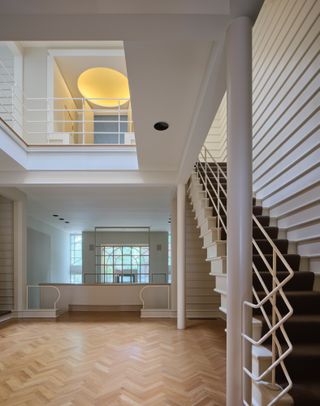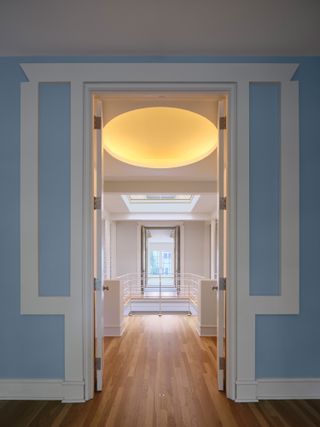Larry Booth's 'House of Light' showcases an impeccable slice of postmodernist heritage
A 1980s Larry Booth-designed Chicago townhouse on a narrow plot is a striking example of his author's work, set alongside the city’s postmodernist archive

Towards the end of the 19th century, when Chicago was the fastest-growing city in the world, it was also, arguably, the most architecturally adventurous. Louis Sullivan was creating organically ornamented towers; Daniel Burnham was building steel-framed mega-blocks; Frank Lloyd Wright was hybridising Arts and Crafts, Japanese and proto-deco Prairie styles; the modern office block and skyscraper were both emerging; and the city’s upper-middle-class houses were a riot of invention and eccentricity.
At some point around half a century later, however, the city became enthralled with the work of Mies van der Rohe, newly arrived from Germany and thoroughly worshipped in his adopted home city. Chicago practice SOM began to produce mini-Mieses for the city, and the minimal, Miesian glass and steel block became Chicago’s new architectural motif, steamrollering (almost) everything else.

Inside Larry Booth's 'House of Light'
By the early 1970s, a rebel resistance arrived in the form of the Chicago Seven, their name a tongue-in-cheek riff on that other Chicago Seven, the anti-Vietnam War counter-culture group who were famously put on trial in 1969. One of the architectural seven was architect Larry Booth, who is now 88. ‘It wasn’t that we didn’t like Mies,’ says Booth. ‘It was more that Chicago was being represented only by that kind of architecture – and it was so much richer.
‘There had been a Miesian show in Munich in Germany and they brought it to Chicago [‘100 Years of Architecture in Chicago’, at the Museum of Contemporary Art, 1976]. So we decided to set up a kind of counter-show, which illustrated that much broader Chicago tradition. That was where the Chicago Seven started.’

At Larry Booth’s House of Light, a central atrium is dominated by a white steel staircase
that winds up several floors in a style evocative of an art deco cruise ship
Some of the other members of the seven are perhaps better known than Booth, their works more widely published, including Stanley Tigerman, James Ingo Freed and Tom Beeby. They were later joined by Helmut Jahn (whose landmark Thompson Center is currently being modified by Google). That counter-show at the Walter Kelly Gallery in 1978 centred around what they called the ‘Exquisite Corpse’.
Inspired by the surrealist parlour game in which players would sketch a portion of a body without seeing the others’ contributions, the seven architects conjured up a row of Chicago townhouses, each a mini-postmodernist experiment, but designed to slot in with their historic neighbours. This speculative street might have had some influence on the ‘Strada Novissima’, which formed the centrepiece of the 1980 Venice Architecture Biennale, directed by Paolo Portoghesi. Here, too, architects were invited to contribute to a postmodernist street with the theme of ‘The Presence of the Past’.

Palladian motifs appear throughout the house in the form of arches and classical alcoves but with a postmodernist bent
Perhaps the least postmodernist contribution of the Chicago Seven, Booth’s design featured a frosted glass façade with a tapering grid of clear openings. He continued to explore the classic Chicago townhouse in its historic street context in his 1983 House of Light, which recently came up for sale.
Wallpaper* Newsletter
Receive our daily digest of inspiration, escapism and design stories from around the world direct to your inbox.
An impeccable slice of postmodern heritage and one which is now perhaps easier to appreciate in its historical context, the house is set on a narrow plot, with a classically inflected symmetrical façade to the street but with expanses of glass so that it appears almost like a public building. Its most surprising feature is a dominating staircase, arranged around a kind of atrium.

‘It’s a narrow house,’ says Booth. ‘And you’re going to be up and down those stairs a lot. We thought there needed to be some joy in climbing those stairs.’ So the walls are striated using mouldings that echo the heights of the stair risers, giving the effect of a series of extremely shallow shelves spanning the entire atrium. It’s a striking touch and, together with the rather nautical-looking steel railings, gives the impression of an art deco cruise ship. Another striking aspect is the clearly Palladian proportions, albeit squeezed into a mannered verticality.
‘Some time around the mid-1970s, I took off to Italy and visited every Palladian villa,’ says Booth. ‘Some were derelict or being used as barns. Palladio’s architecture is actually very simple but it’s all about proportion, and when you’re in these buildings, you really feel it; there’s a sense that this is a real place, a place of balance, proportions and harmony.’

At the time, the work of 16th-century Italian architect Andrea Palladio was being re-embraced, with many architects and theorists attempting to reconcile modernism and Palladianism, a debate that culminated in the 1976 publication of architectural historian Colin Rowe’s essay The Mathematics of the Ideal Villa. A renewed interest in proportion and mathematics (which would bifurcate into postmodern classicism on one side and deconstructivism on the other) saturated the discourse, but Booth’s House of Light is almost like an essay in proportion itself. It has a diagrammatic quality familiar from those sketches of façades subdivided into their mathematical constituents, their golden sections and so on. Beyond the proportions, the Palladian motifs appear here as arched windows and in the complex vocabulary of variously-shaped doorways.
Incredibly, the house has barely been touched in the more than 40 years since it was completed. In that time, it has had four owners, all of whom have clearly enjoyed the interior and left it as it was. Fashions shifted, and postmodernism (even of this rather understated kind) was out of favour for a long time. That is at least partly why so few interiors from that era survive, making this yet more of a welcome oddity. But perhaps precisely because of its sly mix of modernism and postmodernism, its complex, enjoyable elevations and its elision of style, this little house has never quite gone entirely out of fashion. ‘You could say it was postmodern, but I’d say it was more committed to the Renaissance,’ says Booth. It is a rare survivor of a moment that is currently having a bit of a renaissance itself.
This article appears in the October 2024 issue of Wallpaper*, available in print on newsstands, on the Wallpaper* app on Apple iOS, and to subscribers of Apple News +. Subscribe to Wallpaper* today
-
 ‘There are hidden things out there, we just need to look’: Studiomama's stone animals have quirky charm
‘There are hidden things out there, we just need to look’: Studiomama's stone animals have quirky charmStudiomama founder's Nina Tolstrup and Jack Mama sieve the sands of Kent hunting down playful animal shaped stones for their latest collection
By Ali Morris Published
-
 Tokyo firm Built By Legends gives fresh life to a performance icon, Nissan’s R34 GT-R
Tokyo firm Built By Legends gives fresh life to a performance icon, Nissan’s R34 GT-RThis Japanese restomod brings upgrades and enhancements to the Nissan R34 GT-R, ensuring the cult of the Skyline stays forever renewed
By Jonathan Bell Published
-
 Squire & Partners' radical restructure: 'There are a lot of different ways up the firm to partnership'
Squire & Partners' radical restructure: 'There are a lot of different ways up the firm to partnership'Squire & Partners announces a radical restructure; we talk to the late founder Michael Squire's son, senior partner Henry Squire, about the practice's new senior leadership group, its next steps and how architecture can move on from 'single leader culture'
By Ellie Stathaki Published
-
 Light, nature and modernist architecture: welcome to the reimagined Longwood Gardens
Light, nature and modernist architecture: welcome to the reimagined Longwood GardensLongwood Gardens and its modernist Roberto Burle Marx-designed greenhouse get a makeover by Weiss/Manfredi and Reed Hildebrand in the US
By Ian Volner Published
-
 A bridge in Buffalo heralds a new era for the city's LaSalle Park
A bridge in Buffalo heralds a new era for the city's LaSalle ParkA new Buffalo bridge offers pedestrian access over busy traffic for the local community, courtesy of schlaich bergermann partner
By Amy Serafin Published
-
 Tour this Bel Vista house by Albert Frey, restored to its former glory in Palm Springs
Tour this Bel Vista house by Albert Frey, restored to its former glory in Palm SpringsAn Albert Frey Bel Vista house has been restored and praised for its revival - just in time for the 2025 Palm Springs Modernism Week Preview
By Hadani Ditmars Published
-
 First look: step inside 144 Vanderbilt, Tankhouse and SO-IL’s new Brooklyn project
First look: step inside 144 Vanderbilt, Tankhouse and SO-IL’s new Brooklyn projectThe first finished duplex inside Tankhouse and SO-IL’s 144 Vanderbilt in Fort Greene is a hyper-local design gallery curated by Brooklyn studio General Assembly
By Léa Teuscher Published
-
 Tour Ray's Seagram Building HQ, an ode to art and modernism in New York City
Tour Ray's Seagram Building HQ, an ode to art and modernism in New York CityReal estate venture Ray’s Seagram Building HQ in New York is a homage to corporate modernism
By Diana Budds Published
-
 Populus by Studio Gang, the ‘first carbon positive hotel in the US’ takes root in Denver
Populus by Studio Gang, the ‘first carbon positive hotel in the US’ takes root in DenverPopulus by Studio Gang opens in Denver, offering a hotel with a distinctive, organic façade and strong sustainability credentials
By Siska Lyssens Published
-
 This Californian home offers the unexpected through ‘deconstructed’ desert living
This Californian home offers the unexpected through ‘deconstructed’ desert livingGardens & Villas, a home in La Quinta, California, brings contemporary luxury to its desert setting through a collaboration between architects Andrew McClure and Christopher McLean
By Ellie Stathaki Published
-
 First look inside 62 Reade Street, a clock factory turned family home
First look inside 62 Reade Street, a clock factory turned family home62 Reade Street, a boutique New York residential project by architects ODA, unveils its first apartment interior, styled courtesy of Hovey Design
By Ellie Stathaki Published